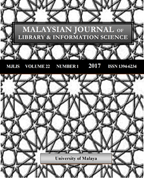Determinants of e-resource usage by open distance learning university students
Main Article Content
Abstract
This study examines the association between socio-demographic and programme-related factors and usage likelihoods of two types of e-resource platforms (E-library and Learning Management System (LMS)) by Open Distance Learning (ODL) university students. Based on stratified random sampling measures, primary data were collected from 1,192 student respondents from an ODL university in Malaysia. Information on socio-demographic characteristics (age, ethnicity, gender, education level, household income) and programme related factors (location of regional centre, year registered, programme of study, attendance to orientation session) were elicited. Logistic regression analysis was applied on two separate outcome variables with affirmative (Y=1) and negative (Y=0) responses reflecting E-library and LMS utilisation. Results indicate that students who are more likely to use E-library consist of older, recent enrolees, and orientation session participants, while Chinese students are less likely to use the facility than their respective peers. Positive LMS usage likelihoods are associated with students who are younger, female, Sijil Tinggi Pelajaran Malaysia (STPM) holders, orientation programme attendees, Science and Technology majors, registered five or more years, and those hailing from the regional centres of Ipoh and Kuala Lumpur. Students from low income bracket households are less likely to utilise LMS than others. Based on these outcomes, several observations are noted to provide university policy-makers with a better understanding of the determinants of Elibrary and LMS utilisation among ODL university students.
Downloads
Article Details
It is a condition of publication that manuscripts submitted to the journal have not been published, accepted for publication, nor simultaneously submitted for publication elsewhere. By submitting a manuscript, the author(s) agree that copyright for the article is transferred to the publisher, if and when the manuscript is accepted for publication.

